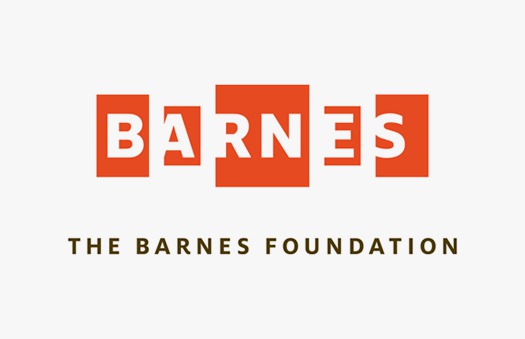
Barnes Foundation identity (via Pentagram)
Last week, Tyler Green of Modern Art Notes linked to a new entry on Pentagram's blog about partner Abbott Miller's identity and website for the Barnes Foundation, in advance of the storied collection's planned re-opening in Philadelphia in May 2012 in a Tod Williams Billie Tsien Architects-designed building. Green picked out and picked on a quote from Miller, who said the new identity, with its irregular line of framed letters, recalls "the DNA of Dr. Barnes's vision." "They killed the Barnes, saved the DNA?" he tweeted.
I tweeted back: "I feel uncomfortable abt designers and architects I admire working on the new Barnes. What are the ethics?" I'm still wrestling with this question, since I admire the work of Abbott Miller and Tod Williams Billie Tsien. I believe them all to be thoughtful people, so I supsect they have wondered this too. Is it better to work to make a flawed project better, or to walk away?
The contentious history of the Barnes Foundation and this move from its existing location in Lower Merion, PA is well-covered in the documentary "The Art of the Steal" and is far too complex for me to summarize. (Lance Esplund did it here.) Suffice it to say, that after watching the documentary, I questioned whether I should ever go to the new Barnes. Now I am questioning what the right thing is for an architect or designer to do. Would refusing the commission (or more likely, refusing to compete) be just an empty gesture? Is it more important that designers who are indeed respectful of the Barnes DNA facilitate the move? Even if I never go (another empty protest?), isn't it better that the new Barnes be good? Dr. Barnes is rolling in his grave anyway.

Barnes Foundation entrance (via TWBTA)
This spring, Michael Murphy started a discussion about ethics for architects with the news that Zaha Hadid had laid off 90 employess when a project in Tripoli was put on hold by "unforseen events in North Africa." He asked, "Why dictator states are the ones sponsoring so many of these projects?
Is the demand for architectural service so limited that we follow the money no matter whom it comes from? What role do architects have in changing this quid pro quo? In laying off a quarter of her staff after losing the Libyan project, Hadid seems to be saying, “Not much.” As an image-maker, she is also signaling, “Who cares?” ... If architects must rely on dictators and free interns to stay afloat, they are practicing a failed business model.It is easy, particularly in hindsight, to say the ethical architect would not have accepted a commission from Qaddafi. But the Barnes situation puts the ethics of design closer to home, and in less stark terms than a dictatorship. But in both cases design makes a bad situation look better. The same could be said of new looks for the same old fast food. I was surprised by the blithe, whatever-it-takes tone of the recent New York Times Magazine article on DJ Stout's (also of Pentagram) rebranding of Popeyes.

Popeyes bags featuring jazz musicians (via Pentagram)
Writer David Segal posed the question "Can good design rescue fast food?" but by "rescue" he only meant increasing market share, not encouraging healthier choices, portion control or any of the other ways design might helpfully intervene in our eating habits. That the tone and topic of his piece fit uneasily under the Times's crusading Michael Pollan-Mark Bittman rhetoric was completely unaddressed. And no one in the article raised an eyebrow about making the food look more "intelligent" by adopting the Whole Foods demographic's "uncluttered surfaces, strong colors and bold lettering" without also changing its content.
The company has said the changes were made to emphasize the brand’s Louisiana heritage and to appeal to younger diners, but the makeover also had the effect of making the food somehow seem more healthful. Was that a goal? “Yes,” says DJ Stout, who oversaw the rebranding for the design firm Pentagram. “At the beginning of any redesign, you have lots of conversations with the owners, and a big part of the packaging assignment was to make the food look healthier.”
Pentagram has performed this trick for more than a few chains, including Ruby Tuesday, Chicken Now and Bobby’s Burger Palace. In each case, the design consultancy favored uncluttered surfaces, strong colors and bold lettering. The results leave diners with the sense that there’s something intelligent about the packaging, and by extension, the restaurant and its food.

Do we hold the designer at all responsible for this bait-and-switch? If obseity is as great a problem in the United States, and particularly in the South, as the rest of the Times says it is, we shouldn't just consider this work clever. It's potentially lethal. When I asked this spring "What Should Food Look Like?" I was thinking about design working in the opposite direction, giving healthy food the appeal of junk, but of course the urbane labeling I described could go the other way. (Also left out of the Times article: the coded class message of "intelligent" and "younger diners.")
I'm still making up my mind about all of this, which makes me uncomfortable in a different way. But I would be interested to hear from practicing designers (particularly the ones mentioned here) about the ethics of practice, where good work comes from, and whether to accept such a commission even seems like a valid question.
